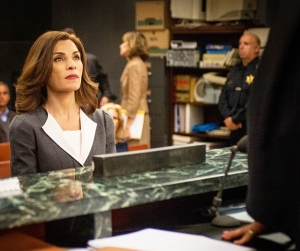In a compelling and rich analysis of serial melodrama, Jason Mittell offers up a reading of the series in his new book on complex television. He claims that the series “complicates its gendered appeals through innovative genre mixing and storytelling strategies” (¶ 41). By this, he means that the show offers up stereotypically masculine and feminine viewing pleasure in order to open up more “fluid possibilities of gender identification” and challenge “rigid stereotypes of gendered appeals” (¶ 23). He notes that, “[t]he personal and professional, effeminate and masculinist, melodramatic and rational are fully interwoven and inseparable both in terms of storytelling structure and affective viewer experience” (¶ 43). While I agree that The Good Wife holds cross-gendered appeal and blends traditionally feminine (emotional and relationship-based) and masculine (rational and action-based) traits, I propose that it works to destabilize these very categories as opposed to only blending them by calling into question the gendered category of “wife.”
Mittell notes that the series is “explicitly gendered by its title, the premise suggests a melodramatic, effeminate focus: a political wife is humiliated by a shameful sex scandal, and forced to both establish her own career and publicly redefine her relationship with her estranged husband” (¶ 41). While the title is explicitly gendered, it also self-reflexively refers to figures of “the good (house)wife” that have peppered the landscape of television. Think of June Cleaver (Barbara Billingsley) of Leave it to Beaver, Carol Brady (Florence Henderson) of The Brady Bunch, Clair Huxtable (Phylicia Rashad) of The Cosby Show, Vivian Banks (Janet Hubert) of The Fresh Prince of Bel-Air, Annie Camden (Catherine Hicks) of 7th Heaven. One might also think of the roles that progressively worked to call into question the constraints outlined for the on-screen wife: Lucy Ricardo (Lucille Ball) of I Love Lucy, Peggy Bundy (Katey Segal) of Married With Children, Roseanne Connor (Roseanne Barr) of Roseanne, Debra Barone (Patricia Heaton) of Everybody Loves Raymond, Carrie Heffernan (Leah Remini) of King of Queens, Lois (Jane Kaczmarek) of Malcolm in the Middle, Carmela Soprano (Edie Falco) of The Sopranos, the Desperate Housewives, or the Army Wives. (Check out this list or this list of memorable TV wives.) One might notice that the majority of these wives populate sitcoms (although the women of Showtime’s dramedies serve as a counterpoint to this observation—Nancy Botwin (Mary-Louise Parker) of Weeds, Jackie Peyton (Edie Falco) of Nurse Jackie, Tara Gregson (Toni Collette) of United States of Tara, Cathy Jamison (Laura Linney) of The Big C). The wife of primetime broadcast television is primarily confined to the sitcom format and to the home. The majority of dramatic wives live on cable or premium channels.
CBS’s The Good Wife, though, begins by uprooting its protagonist Alicia Florrick (Julianna Margulies) from her role as housewife and from her cozy Highland Park home in the very first episode. After Peter’s (Chris Noth) press conference in which he publicly admits to having an affair with a prostitute and subsequently goes to jail on allegations of using government funds for illegal purposes, Alicia moves into her own apartment with her two children and joins a law firm. She bids farewell to her thirteen years as a housewife and stay-at-home mom as she enters the workforce. The viewer only glimpses the house and Alicia’s previous life in it through flashbacks or when Alicia visits it in the episode “Long Way Home.” The series doesn’t restrict Alicia to her job, though. The viewer spends a lot of time with Alicia in and outside of work, in and outside of the home. The viewer watches Alicia interact with her mother and mother-in-law, her husband, her co-workers, her children, her lover and her friends. The series demonstrates the complexities of motherhood and marriage by defining Alicia by attributes other than “mother” and “wife,” yet still grants a nuanced portrayal of both of those roles.
While the series intrigues the viewer with its case-of-the-week structure, the show also builds a complex world of interwoven personal and professional relationships through its serial storytelling (as Mittell also notes). In doing so, it offers up multiple pleasures to the viewers, pleasures that can very well be defined by their cross-gendered appeal. Though that is true, this format and the extended duration of the television serial also allow the show to slowly deconstruct expectations of stereotypical gender roles as it respectfully revises the figure of the TV good wife. The Good Wife, returning to CBS next Sunday (September 21), promises to deliver more of the same in its sixth season as Alicia considers an offer from Eli Gold (Alan Cumming) to act as State’s Attorney, continues to deal with the fallout of her former lover’s death and her for-appearances marriage, and further negotiates the boundaries of what it means to be “the good wife.” (Other reasons to look forward to Season Six include Elsbeth Tascioni (Carrie Preston), Kalinda Sharma (Archie Panjabi), Diane Lockhart (Christine Baranski) and all of her necklaces, and all of Alicia’s fantastic outfits.)
Images from cbs.com
Staci Stutsman is a fourth year PhD student and teaching associate in the English department. She will be taking her qualifying exam on film and television melodrama this fall. She teaches introductory level film and popular culture courses and spends her free time binge watching TV, board gaming, and working out.


You must be logged in to post a comment.